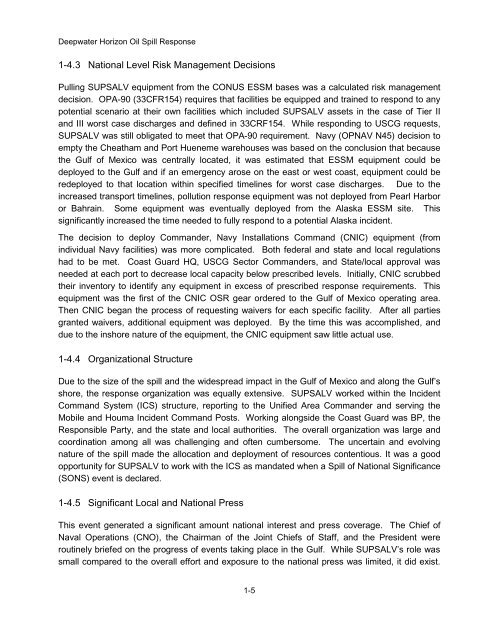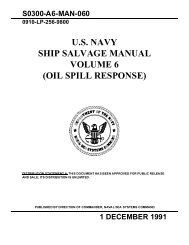U.S. NAVY SALVAGE REPORT DEEPWATER HORIZON ... - ESSM
U.S. NAVY SALVAGE REPORT DEEPWATER HORIZON ... - ESSM
U.S. NAVY SALVAGE REPORT DEEPWATER HORIZON ... - ESSM
Create successful ePaper yourself
Turn your PDF publications into a flip-book with our unique Google optimized e-Paper software.
Deepwater Horizon Oil Spill Response<br />
1-4.3 National Level Risk Management Decisions<br />
Pulling SUPSALV equipment from the CONUS <strong>ESSM</strong> bases was a calculated risk management<br />
decision. OPA-90 (33CFR154) requires that facilities be equipped and trained to respond to any<br />
potential scenario at their own facilities which included SUPSALV assets in the case of Tier II<br />
and III worst case discharges and defined in 33CRF154. While responding to USCG requests,<br />
SUPSALV was still obligated to meet that OPA-90 requirement. Navy (OPNAV N45) decision to<br />
empty the Cheatham and Port Hueneme warehouses was based on the conclusion that because<br />
the Gulf of Mexico was centrally located, it was estimated that <strong>ESSM</strong> equipment could be<br />
deployed to the Gulf and if an emergency arose on the east or west coast, equipment could be<br />
redeployed to that location within specified timelines for worst case discharges. Due to the<br />
increased transport timelines, pollution response equipment was not deployed from Pearl Harbor<br />
or Bahrain. Some equipment was eventually deployed from the Alaska <strong>ESSM</strong> site. This<br />
significantly increased the time needed to fully respond to a potential Alaska incident.<br />
The decision to deploy Commander, Navy Installations Command (CNIC) equipment (from<br />
individual Navy facilities) was more complicated. Both federal and state and local regulations<br />
had to be met. Coast Guard HQ, USCG Sector Commanders, and State/local approval was<br />
needed at each port to decrease local capacity below prescribed levels. Initially, CNIC scrubbed<br />
their inventory to identify any equipment in excess of prescribed response requirements. This<br />
equipment was the first of the CNIC OSR gear ordered to the Gulf of Mexico operating area.<br />
Then CNIC began the process of requesting waivers for each specific facility. After all parties<br />
granted waivers, additional equipment was deployed. By the time this was accomplished, and<br />
due to the inshore nature of the equipment, the CNIC equipment saw little actual use.<br />
1-4.4 Organizational Structure<br />
Due to the size of the spill and the widespread impact in the Gulf of Mexico and along the Gulf’s<br />
shore, the response organization was equally extensive. SUPSALV worked within the Incident<br />
Command System (ICS) structure, reporting to the Unified Area Commander and serving the<br />
Mobile and Houma Incident Command Posts. Working alongside the Coast Guard was BP, the<br />
Responsible Party, and the state and local authorities. The overall organization was large and<br />
coordination among all was challenging and often cumbersome. The uncertain and evolving<br />
nature of the spill made the allocation and deployment of resources contentious. It was a good<br />
opportunity for SUPSALV to work with the ICS as mandated when a Spill of National Significance<br />
(SONS) event is declared.<br />
1-4.5 Significant Local and National Press<br />
This event generated a significant amount national interest and press coverage. The Chief of<br />
Naval Operations (CNO), the Chairman of the Joint Chiefs of Staff, and the President were<br />
routinely briefed on the progress of events taking place in the Gulf. While SUPSALV’s role was<br />
small compared to the overall effort and exposure to the national press was limited, it did exist.<br />
1-5

















